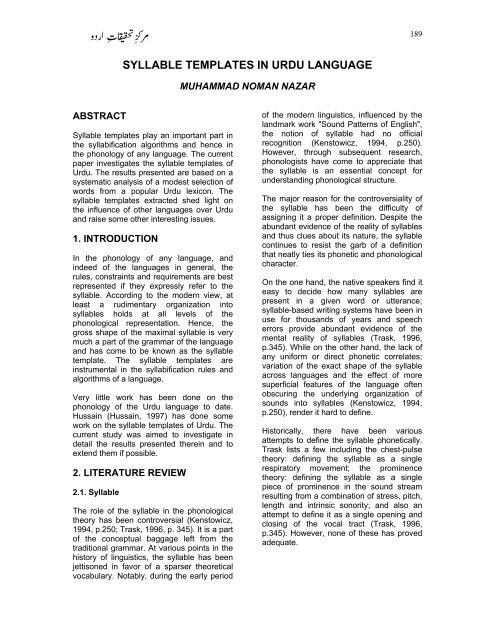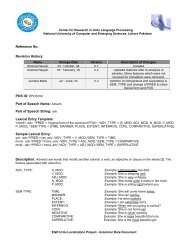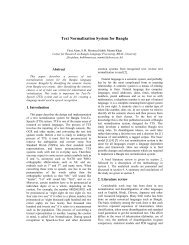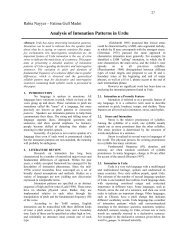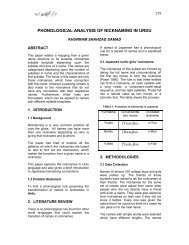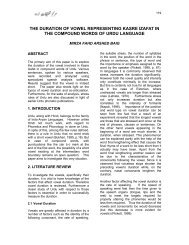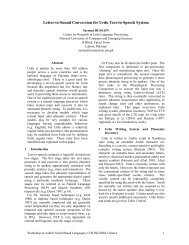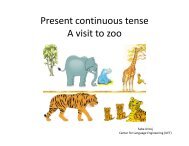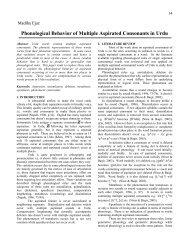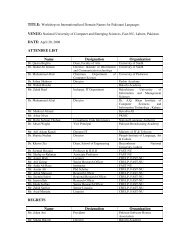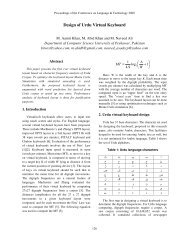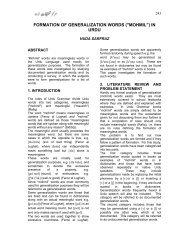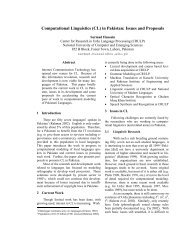SYLLABLE TEMPLATES IN URDU LANGUAGE - Center for ...
SYLLABLE TEMPLATES IN URDU LANGUAGE - Center for ...
SYLLABLE TEMPLATES IN URDU LANGUAGE - Center for ...
You also want an ePaper? Increase the reach of your titles
YUMPU automatically turns print PDFs into web optimized ePapers that Google loves.
189<br />
<strong>SYLLABLE</strong> <strong>TEMPLATES</strong> <strong>IN</strong> <strong>URDU</strong> <strong>LANGUAGE</strong><br />
MUHAMMAD NOMAN NAZAR<br />
ABSTRACT<br />
Syllable templates play an important part in<br />
the syllabification algorithms and hence in<br />
the phonology of any language. The current<br />
paper investigates the syllable templates of<br />
Urdu. The results presented are based on a<br />
systematic analysis of a modest selection of<br />
words from a popular Urdu lexicon. The<br />
syllable templates extracted shed light on<br />
the influence of other languages over Urdu<br />
and raise some other interesting issues.<br />
1. <strong>IN</strong>TRODUCTION<br />
In the phonology of any language, and<br />
indeed of the languages in general, the<br />
rules, constraints and requirements are best<br />
represented if they expressly refer to the<br />
syllable. According to the modern view, at<br />
least a rudimentary organization into<br />
syllables holds at all levels of the<br />
phonological representation. Hence, the<br />
gross shape of the maximal syllable is very<br />
much a part of the grammar of the language<br />
and has come to be known as the syllable<br />
template. The syllable templates are<br />
instrumental in the syllabification rules and<br />
algorithms of a language.<br />
Very little work has been done on the<br />
phonology of the Urdu language to date.<br />
Hussain (Hussain, 1997) has done some<br />
work on the syllable templates of Urdu. The<br />
current study was aimed to investigate in<br />
detail the results presented therein and to<br />
extend them if possible.<br />
2. LITERATURE REVIEW<br />
2.1. Syllable<br />
The role of the syllable in the phonological<br />
theory has been controversial (Kenstowicz,<br />
1994, p.250; Trask, 1996, p. 345). It is a part<br />
of the conceptual baggage left from the<br />
traditional grammar. At various points in the<br />
history of linguistics, the syllable has been<br />
jettisoned in favor of a sparser theoretical<br />
vocabulary. Notably, during the early period<br />
of the modern linguistics, influenced by the<br />
landmark work "Sound Patterns of English",<br />
the notion of syllable had no official<br />
recognition (Kenstowicz, 1994, p.250).<br />
However, through subsequent research,<br />
phonologists have come to appreciate that<br />
the syllable is an essential concept <strong>for</strong><br />
understanding phonological structure.<br />
The major reason <strong>for</strong> the controversiality of<br />
the syllable has been the difficulty of<br />
assigning it a proper definition. Despite the<br />
abundant evidence of the reality of syllables<br />
and thus clues about its nature, the syllable<br />
continues to resist the garb of a definition<br />
that neatly ties its phonetic and phonological<br />
character.<br />
On the one hand, the native speakers find it<br />
easy to decide how many syllables are<br />
present in a given word or utterance;<br />
syllable-based writing systems have been in<br />
use <strong>for</strong> thousands of years and speech<br />
errors provide abundant evidence of the<br />
mental reality of syllables (Trask, 1996,<br />
p.345). While on the other hand, the lack of<br />
any uni<strong>for</strong>m or direct phonetic correlates;<br />
variation of the exact shape of the syllable<br />
across languages and the effect of more<br />
superficial features of the language often<br />
obscuring the underlying organization of<br />
sounds into syllables (Kenstowicz, 1994,<br />
p.250), render it hard to define.<br />
Historically, there have been various<br />
attempts to define the syllable phonetically.<br />
Trask lists a few including the chest-pulse<br />
theory: defining the syllable as a single<br />
respiratory movement; the prominence<br />
theory: defining the syllable as a single<br />
piece of prominence in the sound stream<br />
resulting from a combination of stress, pitch,<br />
length and intrinsic sonority; and also an<br />
attempt to define it as a single opening and<br />
closing of the vocal tract (Trask, 1996,<br />
p.345). However, none of these has proved<br />
adequate.
190<br />
<strong>Center</strong> <strong>for</strong> Research in Urdu Language Processing<br />
According to Trask, two approaches<br />
dominate the syllable in the modern<br />
phonology (Trask, 1996, p.345): -<br />
(1) Syllable is a unit of neural programming,<br />
which can be reconstructed by the hearer<br />
from a variety of clues, in spite of the<br />
absence of any single phonetic correlate.<br />
(2) The syllable is a purely phonological unit<br />
consisting of a single peak of intrinsic<br />
sonority (though with qualifications <strong>for</strong> cases<br />
like English spit, which has two peaks).<br />
Summarily, the syllable can be thought of as<br />
an abstract unit of prosodic organization<br />
through which a language expresses much<br />
of its phonology, although the phonetic<br />
character of the syllable remains unclear<br />
(Kenstowicz, 1994, p.250). In much<br />
contemporary work, syllables are regarded<br />
as more fundamental than segments (Trask,<br />
1996, p.345).<br />
2.2. Syllable Structure<br />
The syllable typically consists of a short<br />
sequence of segments, most typically, a<br />
single vowel or a diphthong, possibly<br />
preceded and/or followed by one or more<br />
consonants. It is now usual to divide the<br />
syllable into an onset and a rhyme, with the<br />
rhyme further subdivided into a nucleus (or<br />
peak) and a coda (Trask, 1996, p.345).<br />
Onset<br />
Syllable<br />
Rhyme<br />
count and thus the location of tone or stress<br />
(Kenstowicz, 1994, p.253).<br />
2.3. Syllabification<br />
Syllabification, an analytical procedure <strong>for</strong><br />
dividing a phonological representation into a<br />
well-defined sequence of syllables, is guided<br />
by two well-established rules:<br />
1. Maximal Onset Principle states that a<br />
consonant, which may in principle occupy<br />
either rhyme or onset, will occupy onset<br />
position (Trask, 1996, p.217).<br />
2. Sonority Sequencing Principle states that<br />
the sonority profile of the syllable must slope<br />
outwards from the nucleus. In other words,<br />
the level of sonority must rise as we proceed<br />
from the beginning of the syllable to the<br />
nucleus and fall as we proceed from the<br />
nucleus to the end in accordance with the<br />
sonority hierarchy (Trask, 1996, p. 328).<br />
(The terms ‘sonority’ and ‘sonority hierarchy’<br />
are explained in the next section.)<br />
These two rules guide the <strong>for</strong>mation of<br />
complex onsets and codas. The notion of<br />
sonority perhaps deserves some elucidation.<br />
Sonority is a phonological property which<br />
lacks a simple phonetic correlate but can be<br />
associated with the output of the periodic<br />
acoustic energy of the segment or with the<br />
degree of aperture of the vocal tract (Trask,<br />
1996, p.327). Phonologists agree that the<br />
entire class of speech sounds can be scaled<br />
in order of their intrinsic sonority as below,<br />
with the vowels as most sonorous and the<br />
stops as least.<br />
Nucleus<br />
FIGURE 1 Structure of the syllable.<br />
Coda<br />
Sonority Hierarchy, (from least sonorous to<br />
most sonorous)<br />
oral stops, fricatives, nasals, liquids, glides,<br />
vowels<br />
2.4. Syllable Templates<br />
The nucleus plus coda <strong>for</strong>m a tighter bound<br />
than the onset plus nucleus (Kenstowicz,<br />
1994, p.252-253). Nucleus has the special<br />
status as the only obligatory constituent. It is<br />
the nucleus, which carries the tone or stress.<br />
Deletion of the nucleus typically relocates<br />
tone or stress, while loss of a consonantal<br />
onset or coda does not disturb the syllable<br />
In the earliest works introducing the syllable<br />
into phonology, syllabification was<br />
per<strong>for</strong>med by a battery of rules applied at a<br />
single point in the derivation or cyclically.<br />
Subsequently, an alternate view emerged<br />
according to which at least a rudimentary<br />
organization into syllables holds at all levels<br />
of the phonological representation. There is<br />
no point where syllabification originates or
191<br />
ceases. There is ample phonological<br />
evidence that supports this view.<br />
The explanation of the phenomenon of<br />
epenthesis, common in many languages, is<br />
a classic case. Epenthesis, or the insertion<br />
of a segment into a word where previously<br />
there was none, relocates the stress, and, in<br />
many cases, results in further phenomena<br />
like syncope, i.e., the deletion of a vowel. In<br />
the derivation of such cases, it was realized<br />
that syllabification is relevant at each step.<br />
Ito (1986) has used epenthesis sites like<br />
these to argue <strong>for</strong> "templatic syllabification."<br />
According to this view, the gross shape of<br />
the maximal syllable is very much a part of<br />
the grammar of the language and has come<br />
to be known as the syllable template<br />
(Kenstowicz, 1994, p. 270).<br />
A syllable template is usually <strong>for</strong>mulated in<br />
terms of sequences of consonants and<br />
vowels. For example, Arabic language<br />
defines CV(V)C as its syllable template,<br />
where C denotes a consonant, V denotes a<br />
Vowel and the parentheses “( )” indicate<br />
optionality in the templatic<br />
elements.(Kenstowicz, 1994, p. 270).<br />
Ito shows that templatic syllabification allows<br />
a simpler and more successful analysis of<br />
phenomena like epenthesis than the<br />
conventional syllabification-by-rule model.<br />
Syllabification consists in a directional<br />
mapping of the phonemic string to the<br />
appropriate positions in the template,<br />
matching vowels with V positions and<br />
consonants with C positions.<br />
Syllable templates represent a fixed static<br />
set of constraints that dictate the syllable<br />
structure in the language concerned.<br />
Although, there is some evidence to suggest<br />
that templatic syllabification may need some<br />
revision (Kenstowicz, 1994, p. 276), the<br />
model is still relevant and valid <strong>for</strong><br />
languages with an elementary syllable<br />
inventory like Arabic.<br />
2.5. Syllable Templates of Urdu<br />
Urdu belongs to the family of New-Indo-<br />
Aryan languages, which is a sub-branch of<br />
Indo-European languages. Urdu is similar to<br />
Hindi and both are derived from Khari Boli or<br />
Dehlvi (Kachru, 1987). Although, both<br />
languages have the same origins and the<br />
same linguistic structure, Urdu phonetics<br />
and phonology have diverged from Hindi<br />
phonetics and phonology. The divergence is<br />
caused by the strong Perso-Arabic influence<br />
on Urdu and the strong Sanskrit influence on<br />
Hindi. (Hussain, 1997, p.40). According to<br />
Saxena, Urdu has retained its resilience in<br />
that it is characteristic of the language that it<br />
absorbs the words and phrases of other<br />
languages easily within its own grammatical<br />
structure. In fact it is the chief source of the<br />
continuing evolution of Urdu. On the other<br />
hand, Hindi has retracted back to its<br />
Sanskrit origins and has become more<br />
discriminating in allowing words of other<br />
languages to invade its boundaries (Saxena,<br />
1978, p.2).<br />
According to Saxena the languages that<br />
have been most influential in development of<br />
Urdu are Persian, Arabic, English,<br />
Portugese and a host of local languages<br />
spoken in India at the time (Saxena, 1978,<br />
p.2-6). These languages continue to cast<br />
their influence in the direction of evolution of<br />
the Urdu language. It is there<strong>for</strong>e expected<br />
that an investigation of the syllable<br />
templates of Urdu should reveal results very<br />
similar to the templates of these languages.<br />
Also, the very prominent characteristic of<br />
Urdu, that of absorbing almost any word of<br />
other languages within its own grammatical<br />
framework suggests that the syllable<br />
templates of Urdu should comprise a rich<br />
reservoir. Moreover, it hints about the<br />
richness of its grammatical constructs also.<br />
Undertakings in the syntax, morphology and<br />
semantics of Urdu should there<strong>for</strong>e be<br />
worthwhile <strong>for</strong> the researchers. However,<br />
the current scope is restricted to the syllable<br />
templates only.<br />
3. METHODOLOGY<br />
The current investigation of relies on the<br />
“Jaibi Feroze-ul-Lughat, Feroze Sons,<br />
Lahore,” which lists the Urdu words of<br />
common usage. There are more than twenty<br />
thousand of these words present in the<br />
dictionary. Five thousand of these words<br />
were chosen and examined to yield the<br />
syllable structure.
192<br />
<strong>Center</strong> <strong>for</strong> Research in Urdu Language Processing<br />
As in any language, there are some Urdu<br />
letters that are more popular or frequent<br />
than others in serving as the start of the<br />
word. The selection of the words aimed to<br />
provide equal representation to the words<br />
with the lower frequency and higher<br />
frequency. The number of words in the<br />
dictionary were listed down in descending<br />
order of starting-letter-frequency, indicated<br />
by the number of pages devoted to each<br />
alphabet. The words to be analyzed were<br />
then chosen alternately from the beginning<br />
and ending of this list. The reasoning behind<br />
this procedure is the assumption that if there<br />
are less number of words with a particular<br />
letter in the starting position than another,<br />
then there may some constraint upon its<br />
<strong>for</strong>mation that rejects most of the<br />
possibilities. Hence an investigation of the<br />
high frequency words alone may not<br />
elucidate this constraint. However, the high<br />
frequency words themselves represent a<br />
more generous constraint and there<strong>for</strong>e<br />
must not be completely ignored. An equal<br />
representation of both classes seemed the<br />
best choice and was adopted.<br />
Another important consideration was the<br />
unbiased analysis of the structure of<br />
syllable. Since a native speaker of the<br />
language is best qualified to render<br />
judgement in this case, the analysis was<br />
based on the judgement of such a speaker,<br />
which in this case is the author himself.<br />
There is no standard transcription of Urdu<br />
words available, hence, care was necessary<br />
to avoid the bias that would have crept in<br />
had the author first transcribed the word and<br />
then attempted to analyze it. That is<br />
because the <strong>for</strong>mal phonological training of<br />
the author would have come into play, in<br />
following the rules of syllabification and then<br />
making out syllables instead of judging the<br />
syllables from the spoken word and then<br />
figuring out their inherent templatic structure.<br />
There<strong>for</strong>e, the words of Urdu from the<br />
dictionary were not transcribed, to obtain the<br />
best-unbiased data.<br />
Another important aspect of the selection of<br />
words was to discriminate between the<br />
words of Urdu as opposed to those with a<br />
distinctly English origin. The reasons <strong>for</strong> this<br />
are given in the Discussion section.<br />
4. RESULTS<br />
The study reveals the following syllable<br />
templates of Urdu, listed in order of<br />
descending percentage frequency.<br />
CVV 39<br />
CVC 20<br />
CVVC 15<br />
CV 17<br />
CVCC 3.2<br />
VV 2.5<br />
VVC 1.5<br />
VC 1.0<br />
CVVCC 0.3<br />
V 0.4<br />
VCC 0.05<br />
As mentioned earlier, the syllable structure<br />
was based upon the judgement of a native<br />
speaker and the source upon which the<br />
investigation was based is "Feroz-ul-Lughat<br />
Jaibi(ref).<br />
5. DISCUSSION<br />
Urdu makes use of both short and long<br />
vowels, where the short vowels are denoted<br />
by diacritical marks and the long ones by<br />
special alphabets in script. It is there<strong>for</strong>e<br />
instructive to rearrange the given templates<br />
into two groups based upon the length of the<br />
vowel.<br />
CVV 39 CV 17<br />
CVVC 15 CVC 20<br />
CVVCC 0.3 CVCC 3.2<br />
VV 2.5 V 0.4<br />
VVC 1.5 VC 1.0<br />
VCC 0.05<br />
Each group is represented almost wholly by<br />
its first two members in terms of percentage<br />
frequency volume. There<strong>for</strong>e it seems that a<br />
simple onset of one consonant, followed by<br />
a short or a long vowel, optionally followed<br />
by a simple coda of one consonant, i.e.<br />
CV(V)(C) is the makeup of the most natural<br />
syllable in Urdu.<br />
Urdu language does not license a short<br />
vowel in word final position. That is, the (C)V<br />
template can never be at the end of a word.
193<br />
Templates with the same popular makeup<br />
but having complex coda of two consonants,<br />
i.e. CV(V)(CC) are less preferred but<br />
comprise a significant fraction of the<br />
remaining percentage.<br />
A syllable lacking an onset is least preferred<br />
and hence the template that comprises the<br />
lowest frequency is V(V)(C). The most<br />
striking feature of this makeup is the fact<br />
that the template VVCC containing a long<br />
vowel and a complex coda but lacking an<br />
onset consonant is prohibited completely.<br />
The first and the most popular template<br />
CV(V)(C) is clearly the influence of Arabic<br />
on Urdu. From the knowledge of the author,<br />
Persian also possesses the same syllable<br />
template as being most popular. Although<br />
the syllable templates of Persian could not<br />
be located in a brief search of literature, it<br />
seems reasonable of assume that the<br />
CV(V)(C) template is the combined influence<br />
of Arabic and Persian on Urdu. The<br />
influence of Sanskrit in the <strong>for</strong>mation of this<br />
syllable template could not be investigated<br />
due to ignorance of the author to the<br />
language concerned and non-availability of<br />
literature. The conclusion, however, is<br />
corroborated in part by Saxena (Saxena,<br />
1978, p. 2-6), who maintains that the biggest<br />
influence that any language has had on the<br />
shaping of Urdu is the Persian language.<br />
The evolution of a complex coda in the<br />
same makeup, i.e. the template CV(V)CC<br />
hints towards a Persian influence, though,<br />
this statement again remains to be<br />
corroborated.<br />
There are limitations on the <strong>for</strong>mation of the<br />
complex coda, primarily guided by the<br />
Sonority Sequencing Principle, which<br />
requires the sonority of the two consonants<br />
in the coda to be in descending order.<br />
However, these limitations do not seem as<br />
pronounced as mentioned in Hussain<br />
(Hussain, 1997, p.42), who maintains that<br />
"when there are two coda consonants, the<br />
first consonant in the coda is limited to a<br />
voiceless fricative or nasals and the second<br />
consonant is limited to stops." A common<br />
counter-example is the "rz" coda in many<br />
Urdu as in "Farz". As pointed out also by<br />
Hussain, detailed phonetic study of the<br />
construction of complex codas still needs to<br />
be done.<br />
Syllable weight should also play a significant<br />
role in the <strong>for</strong>mation of Urdu templates.<br />
Apparently the bi-moraic syllables (i.e.<br />
syllables made of two units of weight) <strong>for</strong>m<br />
the most preferred class of templates.<br />
Furthermore, the results also indicate a hint<br />
of extra-syllabicity (i.e. a unit consonantal or<br />
vowel, that has no moraic weight), as<br />
without it the Urdu would seem to possess a<br />
super-super-heavy syllable in the <strong>for</strong>m of the<br />
CVVCC template. The moraic analysis of<br />
the Urdu syllables is there<strong>for</strong>e a promising<br />
direction of research.<br />
The last category i.e. the template shorn of<br />
an onset cluster but otherwise following the<br />
same makeup V(V)(C)(C) again shows the<br />
same pattern. The V(V)(C) subset takes up<br />
most of the percentage volume of this<br />
category. While the introduction of another<br />
consonant in the coda, i.e. V(V)CC is<br />
constrained to such a limit that the one<br />
possibility VCC is severely restricted while<br />
the other VVCC is totally prohibited.<br />
Perhaps the most remarkable result of these<br />
investigations is the fact that the complex<br />
onset mentioned by Hussain (Hussain,<br />
1997, p.42) is totally absent in the results.<br />
However, a justification <strong>for</strong> this finding may<br />
be a bit controversial. The finding and its<br />
authenticity itself depend upon the<br />
discrimination practiced against words of the<br />
English origin imported in Urdu sentences.<br />
The reasoning <strong>for</strong> this is simple: the author<br />
judges himself not qualified in divining the<br />
structure of syllables in such words. This<br />
reasoning is based upon two important<br />
factors. Firstly, the author has been exposed<br />
to English language <strong>for</strong> close to fifteen<br />
years. Thus, the opinion of the author could<br />
never be unbiased in case of the Urdu-ized<br />
English words. Secondly, some pilot work<br />
done by the author to confirm or reject this<br />
bias, by putting the syllable structure of a<br />
select few words to the judgement of<br />
volunteers, has almost always resulted in<br />
disagreement. It seems that English words<br />
that have been in long usage in Urdu have<br />
had themselves resyllabified in most cases.<br />
The status of such Urdu-ized English words<br />
is there<strong>for</strong>e an open question. A detailed<br />
phonetic study needs to be done with
194<br />
<strong>Center</strong> <strong>for</strong> Research in Urdu Language Processing<br />
carefully chosen volunteers from amongst all<br />
education groups, as English education is<br />
the most important factor affecting the<br />
perceived syllable structure of such words. It<br />
is expected that the results of such a study<br />
will further enlarge the inventory of syllable<br />
templates of Urdu.<br />
6. REFERENCES<br />
Hussain, S., 1997, Phonetic Correlates of<br />
Lexical Stress in Urdu, Unpublished Ph.D.<br />
dissertation, Northwestern University, IL,<br />
USA.<br />
Jaibi, Feroz-ul-Lughat, Urdu, Feroze Sons,<br />
Lahore.<br />
Kachru, Y., 1987, “Hindi-Urdu,” in The Major<br />
Languages of South Asia, The Middle East<br />
And Africa, Comrie, B. (eds.), Routledge,<br />
London, UK.<br />
Kenstowicz, Micheal., 1994, Phonology In<br />
Generative Grammar, Blackwell<br />
Publications.<br />
Napoli, Donna Jo., 1996, Linguistics, An<br />
Introduction, Ox<strong>for</strong>d University Press.<br />
Saxena, Ram Babu., 1978, Tareekh-e-<br />
Adab-e-Urdu, Askari (trans.), Kashmiri(eds.).<br />
Trask, R. L., 1996, A Dictionary Of<br />
Phonetics And Phonology, Routledge,<br />
London, UK.


